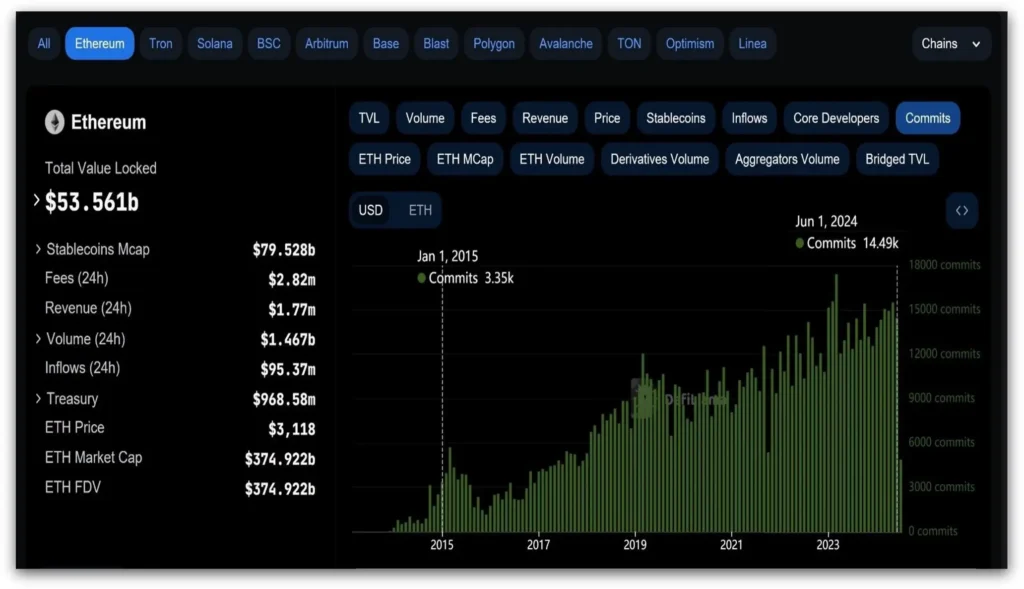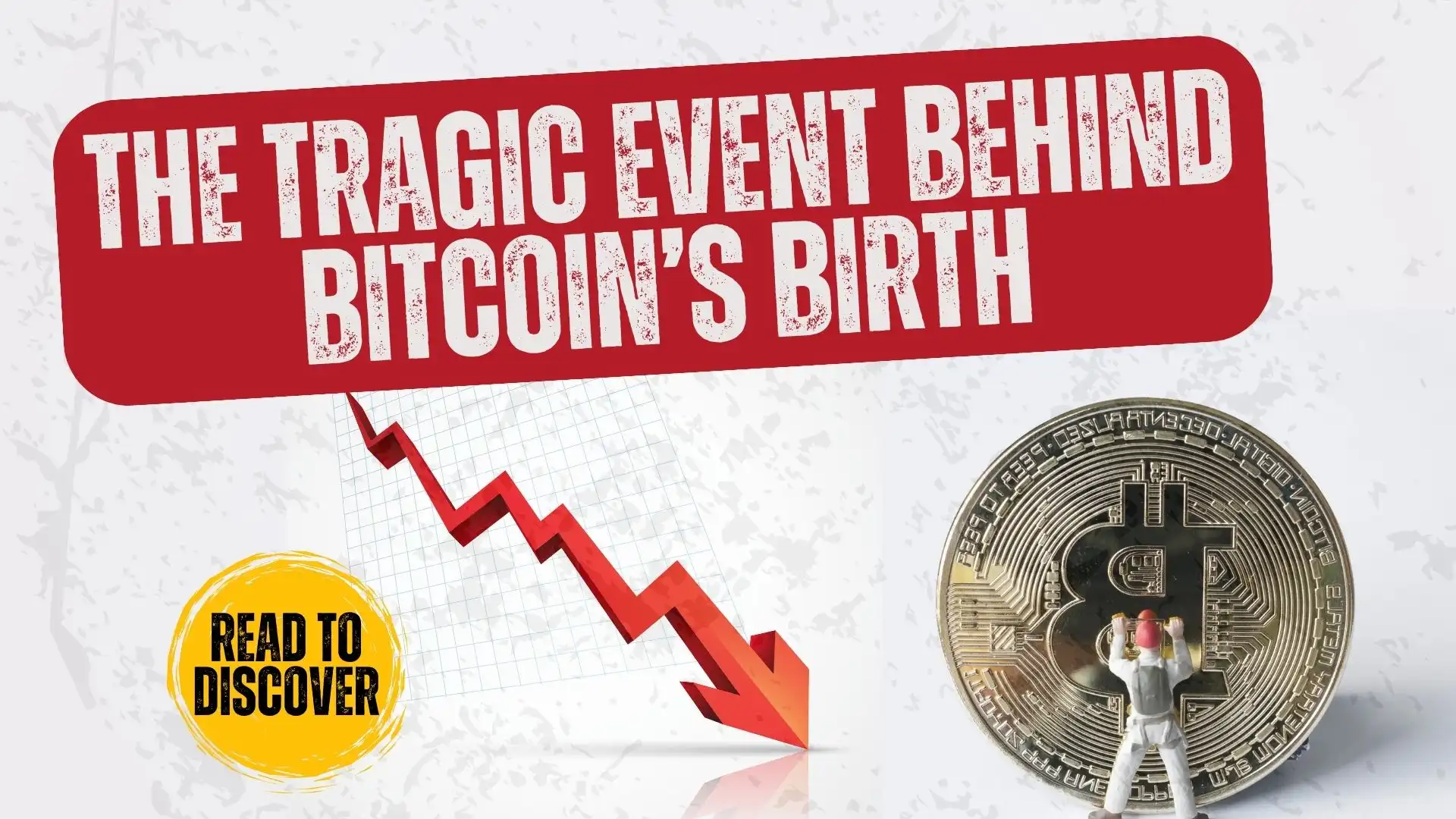Imagine a world where transactions are seamless, contracts are smart, and applications are decentralized. Welcome to Ethereum, the groundbreaking platform created by Vitalik Buterin in late 2013 and launched in July 2015.
In this blog, we aim to analyze data from various web sources to substantiate facts and reinforce our belief that ETH is poised to become the next booming currency. We will delve into key metrics, trends, and insights to illustrate Ethereum’s potential for significant growth and adoption shortly.
This blog covers statistics such as political influence, institutional adoption, Exchange Traded Funds ETF developments, increases in developers and commits, and compares the approval process and subsequent market reaction of the Bitcoin Exchange Traded Funds ETFs with ETH. It emphasizes the importance of seizing the opportunity to include ETH in our portfolio profile, highlighting why it shouldn’t be overlooked.
Table of Contents
Ether (ETH): Fueling the Digital Revolution
Brief Introduction to Ether ETH
At its core is Ether (ETH), the native cryptocurrency that powers this decentralized, open-source ecosystem. Ether is the lifeblood of Ethereum, facilitating transactions, executing smart contracts, and supporting a myriad of decentralized protocols, making it a vital force in the blockchain revolution.
Ether acts as the “gas” for Ethereum, powering the network by incentivizing the computational work needed for smart contracts and transactions. When we use Ethereum, we pay fees in Ether, known as “gas fees,” to compensate miners and validators.
This ensures the network runs efficiently and securely while preventing spam.
We know that most of the Altcoins are on Ethereum, Similarly most of the NFTs and a wide range of decentralized applications and decentralized finance exchanges are made up on the Ethereum platform with solidity. We recognize Solidity as the easiest programming language to learn.
It’s considered one of the easiest programming languages to learn for blockchain development, allowing for the creation of any application with a viable use case. In our opinion, this capability marks a significant advancement in the field.
In the broader crypto ecosystem, we see Ether as the second-largest cryptocurrency by market capitalization, playing a crucial role in DeFi (Decentralized Finance). It’s often used as collateral in DeFi protocols, allowing us to earn interest, lend, borrow, and trade assets.
As we explore the following sections on institutional adoption, political acceptance of crypto, and market statistics, we’ll uncover how institutions, investment firms, and banks are increasingly interested in this cryptocurrency.
What factors indicate that now is the right time to invest in Ethereum, highlighting its bullish potential?
The Institutional Interest: Exchange Traded Funds
Although it is not yet completely sanctioned for trading, the Ethereum Exchange Traded Fund (ETF) has received partial permission, showing progress in the regulatory process. In particular, the approval of the 19B form—a critical regulatory document—has occurred. Still pending, though, is the S1 form—another essential step in the licensing procedure.
The Ethereum Exchange Traded funds (ETF) will be listed on the exchange and trading will be enabled after they have been fully approved. The eagerness for its final clearance has attracted a lot of interest, especially from financial analysts and institutional investors.
According to recent remarks made by the CEO of well-known cryptocurrency investing company Grayscale, complete clearance might be given in a matter of weeks. These changes have sparked conjecture and anticipation regarding the possible effects on Ethereum’s market performance once the exchange-traded funds (ETF) are open for trading have been sparked by these updates.
The approval procedure and subsequent market response of the exchange traded funds (ETF) for Bitcoin offer an insightful comparison to put things in perspective. It took about a week for the S1 form for the Bitcoin Exchange Traded Funds ETF to be approved.
With the approval of the BTC ETF, Bitcoin experienced a significant price surge, rising from $40,000 to a record high of $73,000.This rapid price escalation was driven by increased investor confidence and substantial inflows from institutions, investment firms, and banks. This approval makes BTC bullish in long-term meaning BTC will also continue its uptrend in the long term

In the data from coinmarketcap.com, as shown in the above figure, we see that the initial market cap of Bitcoin at the time of the Exchange Traded Funds’ ETF approval was about $914.92 billion. Within 49 days of the approval, the market cap increased by about $1.4 trillion, showing regulatory approval’s profound impact on a cryptocurrency’s market dynamics. This regulation increased the trust of institutional investors resulting in their acquisition of BTC.
With a current market cap of approximately $400 billion and priced at $3167, Ethereum stands as a significant player in the crypto market. We can see from the following chart from coinmarketcap.com that the market cap has started increasing in ETH.

This heightened institutional investment and participation by market makers and ETH’s versatility and Ethereum’s growing adoption in the digital financial landscape could potentially catapult its market cap to tenfold, thereby boosting its value by 5-10 times.

The Ethereum Exchange Traded Funds (ETF) approval could potentially mirror Bitcoin’s experience, leading to significant market activity and price appreciation. Institutional investors and financial entities are likely to take a keen interest, contributing to increased liquidity and market cap growth.
The historical precedent set by Bitcoin’s Exchange Traded Funds (ETF) approval indicates that similar regulatory milestones for Ethereum could attract substantial investment and drive its market value higher.
Political Dynamics at Play: US Elections 2024
The U.S. Election is coming up in November 2024, and Trump has announced that his campaign will start accepting cryptocurrency donations. Trump is looking to cryptocurrencies like Bitcoin, Ethereum, and Solana to raise donations.
The crypto community knows that Trump is in favor of cryptocurrency, Many people think that if Trump wins, it will result in large financial inflows into the blockchain industry and expand his base of support.
Democrats were expecting this to happen. Their administration turned things around completely and was ahead of the curve, shocking everyone with Ethereum’s unexpected Exchange traded funds’ acceptance.
The United States has started supporting cryptocurrency, as it has started to accept it as legal money in the form of Exchange traded funds, or ETFs.
Institutional investors who have multimillion-dollar portfolios find it simpler to invest in Ethereum through Exchange Traded funds (ETFs) rather than dealing with the hassles of handling wallet management or direct token purchases.
Investors will be able to purchase Ethereum via these Exchange Traded funds (ETFs), which will be offered by well-known trading platforms including TD Ameritrade and Charles Schwab as their money is much more safe, secure, and insured with these firms.
Well-known trading platforms like TD Ameritrade and Charles Schwab will offer ETH Exchange Traded Funds (ETF) to be purchased by investors
What makes it bullish? All the attributes discussed in this section, including government adoption, ETF approval, and interest from political parties like Republican and Democratic, contribute to its bullish outlook in the long run.
Layer 2 Solutions: Scaling New Heights
We know that the main Ethereum blockchain (Layer 1) has limitations in terms of transaction speed and cost, in which cost usually increases times of high network congestion.
The protocols or mechanisms built on the Ethereum blockchain to improve its scalability and efficiency are known as Layer 2 solutions. Roll-ups and Optimism are the main examples of layer 2 solutions these solutions reduce congestion and lower transaction costs while maintaining security and enhance Ethereum’s usability for dApps, improve user experience, and support broader adoption by making transactions faster and cheaper.
Thanks to layer 2 solutions Ethereum can now handle a larger volume of transactions efficiently, making it more attractive for decentralized applications. Hence strengthening long-term bullish sentiment.
Staking: A Lucrative Opportunity
We know that Ethereum operates on a Proof of Stake system, meaning that if you hold and stak your Ether, you help secure the network. In return, you earn a portion of the transaction fees generated on the Ethereum network.
Whereas Ethereum has increased its staking rewards from 2-3% to 4-5% on the staked amount making it a viable and attractive offer for investors to invest in contrast to traditional banks in the U.S. typically offer no more than 1-2% interest
According to the data, the total amount of staked Ether has been increasing since October 2023. Back in October 2023, the amount of staked Ether was about $22.75 billion, and now it has grown to approximately $53.56 billion.
This demonstrates the influx of money into ETH and the rising interest from institutional investors in this currency. Below is a picture of the data showing the increase in the amount of staked ETH from October 2023 to July 2024, TVL stands for Total Value Locked courtesy of Defillama.com

This makes Ethereum a potentially lucrative investment compared to traditional financial products.
Developer Activity: The Heartbeat of Ethereum
The increasing number of developers working on Ethereum signifies several positive developments for both the Ethereum ecosystem and the broader cryptocurrency landscape. In January 2015, only 43 developers were working on Ethereum. As of July 2024, this number has grown close to 500, with the developer count continuing to rise daily. Following is the data from Defillama.com showing the increase in developers’ number since day one.

When the number of developers working on Ethereum increases, it signifies several positive developments for the Ethereum ecosystem and the broader cryptocurrency landscape,
More developers lead to the creation of diverse and advanced projects, applications, and innovations, such as dApps and smart contracts.
A larger developer community contributes to the expansion of the Ethereum ecosystem, improving the core protocol and developing new tools, frameworks, and services.
Increased developer activity enhances network security by identifying and fixing bugs, improving resilience, and ensuring the security of smart contracts and applications.
A growing developer community offers better support through forums, documentation, and collaboration, making it easier for new developers to get involved and for existing developers to solve problems.
More developers indicate growing interest and confidence in Ethereum, attracting users, investors, and businesses, and driving adoption and integration into various industries.
The increase in developers can lead to new projects and businesses, creating job opportunities, investment potential, and growth in the decentralized economy, potentially increasing the demand for Ether (ETH).
While predicting exact price movements is challenging, the increased developer activity and corresponding ecosystem growth create a bullish outlook for Ethereum in the long run. However the price depends on various factors, including market conditions, competition, regulatory developments, and overall adoption of blockchain technology, the foundation for significant long-term growth appears strong.
Rising Commit Activity: Fueling Ethereum’s Bullish Outlook
Commits in the Ethereum blockchain context refer to the incremental changes and updates made to the codebase, tracked in a version control system. They are fundamental to the development process, enabling collaboration, transparency, and continuous improvement of the Ethereum ecosystem. We can see in the following picture from defillama.com that from Jan 2015 till Jun 2024 we have seen significant growth in commits that is from 3.35k to 14.49k.

An increase in commits can have a bullish impact on Ethereum by signaling active development, continuous improvement, and growing confidence in the platform. Here’s how:
Frequent commits indicate that developers are actively working on new features, enhancements, and innovations. This can lead to new applications and use cases for Ethereum, attracting more users and developers.
Regular commits suggest that issues and bugs are being addressed promptly, improving the overall functionality and user experience of the platform. Hence it is problem solving.
Updates often include optimizations that make the network more efficient, scalable, and capable of handling higher transaction volumes. This can enhance Ethereum’s competitiveness, usability, and overall performance.
Frequent commits may include security patches and improvements, making the network more secure against vulnerabilities and attacks, thus increasing trust among users and investors.
Active commits history demonstrates transparency in the development process, allowing the community to see ongoing efforts to improve the platform. This transparency builds trust and confidence in Ethereum’s future.
Increased commits can also reflect a vibrant and engaged developer community, which is a positive signal to investors and users. A strong community can drive further adoption and support.
As developers continuously improve and expand Ethereum’s capabilities, it can lead to the creation of more decentralized applications (dApps), which increases the network’s utility and attractiveness.
Active development can attract institutional investors who seek platforms with strong growth potential and technological advancement.
As Ethereum’s network improves and more applications are built, the Demand for ETH (used for transaction fees and smart contracts) is likely to increase, driving up its price.
Positive Sentiment from the community and investors, driven by visible and continuous improvements, can lead to a bullish outlook and increased investment in ETH.
An increase in commits reflects active and ongoing development, which can lead to technological advancements, improved security, and greater adoption. This active development can enhance community confidence, attract institutional interest, and drive demand for Ether (ETH), contributing to a bullish sentiment and potentially increasing the price of Ethereum in the long run.
Conclusion: The Road Ahead
In this blog, we’ve explored several key aspects that indicate why now might be an opportune time to invest in Ethereum (ETH), focusing on various factors contributing to its potential growth and value in the cryptocurrency market.
One significant topic covered is the potential impact of an Ethereum Exchange Traded Funds (ETF) on the market price of ETH. An Exchange Traded Funds (ETF) approval could bring substantial institutional interest and investment into Ethereum. We discussed how the Exchange Traded Funds approval process works, including the stages to pass through regulatory scrutiny.
We’ve explored why big investment firms and institutional investors are increasingly interested in Ethereum. This interest stems from Ethereum’s role in the broader digital economy, particularly in decentralized finance (DeFi) and smart contracts attracting investors seeking exposure to blockchain technology beyond just cryptocurrencies.
The blog also delved into how geopolitical events, such as the US elections, can influence the sentiment and investment decisions surrounding Ethereum. Political support and regulatory clarity play a crucial role in shaping the market’s perception of Ethereum and other cryptocurrencies.
We discussed the Ethereum ecosystem’s strength, emphasizing the growth in the number of developers and commits. A vibrant developer community indicates ongoing innovation and improvement within the Ethereum network.
This activity not only enhances Ethereum’s technical capabilities but also supports its long-term viability and attractiveness to developers, businesses, and users.
Finally, the overarching theme of the blog is to provide insights into why now might be an optimal time to consider investing in ETH. Despite its current market position, Ethereum is still considered in its early stages relative to its potential impact on the global economy.
The blog encourages readers to view Ethereum’s potential through a long-term lens, highlighting its capacity to reshape industries and economies in the decades ahead.
The true wealth is built by those who hold onto an asset for the long term.
FAQs
Why is Ethereum considered a good investment now?
Ethereum’s potential growth is driven by factors such as institutional adoption, regulatory advancements with Exchange Traded Funds (ETFs), increased developer activity, and its critical role in decentralized finance (DeFi).
What are Exchange Traded Funds (ETFs) and their significance for Ethereum?
ETFs are investment funds traded on stock exchanges. Ethereum ETFs, once fully approved, could attract significant institutional investment, potentially boosting Ethereum’s market value and liquidity.
How does Ethereum compare to Bitcoin in terms of ETF approval?
Ethereum’s ETF approval process is still ongoing. Bitcoin saw a significant price surge following its ETF approval, indicating potential positive market reactions for Ethereum as well.
What impact could the US elections have on Ethereum?
Political dynamics, such as support for cryptocurrencies by political candidates, could influence investment inflows into Ethereum and shape regulatory policies, potentially affecting its market performance.
What are Layer 2 solutions and their benefits for Ethereum?
Layer 2 solutions, like Roll-ups and Optimism, improve Ethereum’s scalability by reducing congestion and transaction costs. They enhance Ethereum’s usability for decentralized applications (dApps).
What is staking in Ethereum, and why is it beneficial?
Staking in Ethereum involves holding and locking Ether to help secure the network, earning rewards in return. Increased staking rewards make it an attractive investment compared to traditional banks.
How does developer activity impact Ethereum?
Increased developer activity signifies ongoing innovation and improvements in Ethereum. It enhances the ecosystem, attracts more users, and drives the platform’s growth and security.
Why is now considered a good time to invest in Ethereum?
With growing institutional interest, advancements in regulatory approval for ETFs, increased developer activity, and significant adoption in DeFi, Ethereum is poised for substantial growth, making it a potentially lucrative long-term investment.



4 thoughts on “Ethereum’s Next Surge: Don’t Miss the Crypto Goldmine with Exchange Traded Funds!”